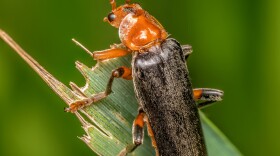Fuzzy, light brown in color, and with a snout looking like Pinocchio went on a fibbing spree, the Acorn Weevil has a comical appearance.
Their most prominent feature is a long, curved snout, called a rostrum. Both males and females have rostrums, but in a “biggest rostrum competition” the females would win every time. Their snouts are about the length of their entire body.
Females use their sensitive antenna to search for acorns that are just right for the task at hand …becoming the perfect place to lay her eggs.
But if you’ve ever tried it, opening an acorn is not so easy …especially if you’re an insect less than a half inch in length.
Focused on acorns still hanging in the tree, female acorn weevils sport sharp mouth parts at the tip of their rostrum to cut into the outer layer of the nut. Once she breaks through, the hard work begins.
Doing what many insects can’t, due to the rigid structure of their exoskeletons, the acorn weevil begins to drill into the acorn by rotating her head from side to side … looking like she’s saying “no” to a never-ending list of questions.
Once she’s drilled a suitable hole, she uses a tube-like ovipositor at end of her abdomen to lay eggs into the acorn, providing a safe home and food for her developing young.
Later in the season, after the acorns have fallen, the weevil larvae will chew their way out, burry in the soil to pupate, and emerge a year or two later …just in time to take advantage of next season’s acorn crop.





